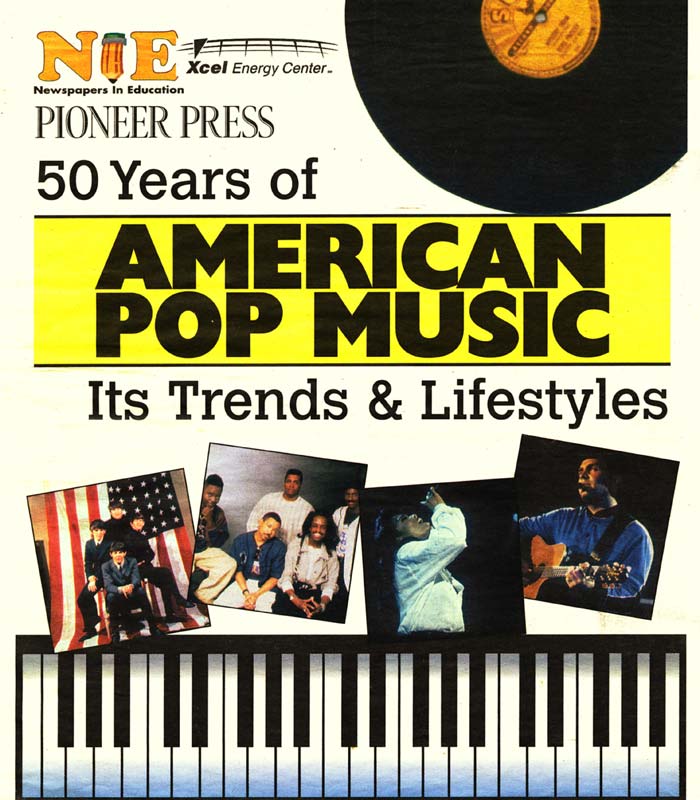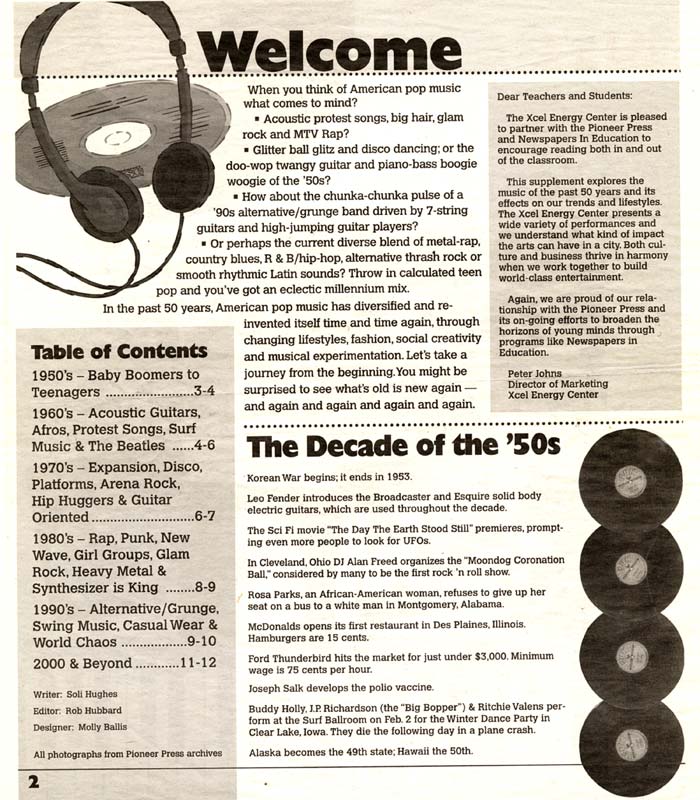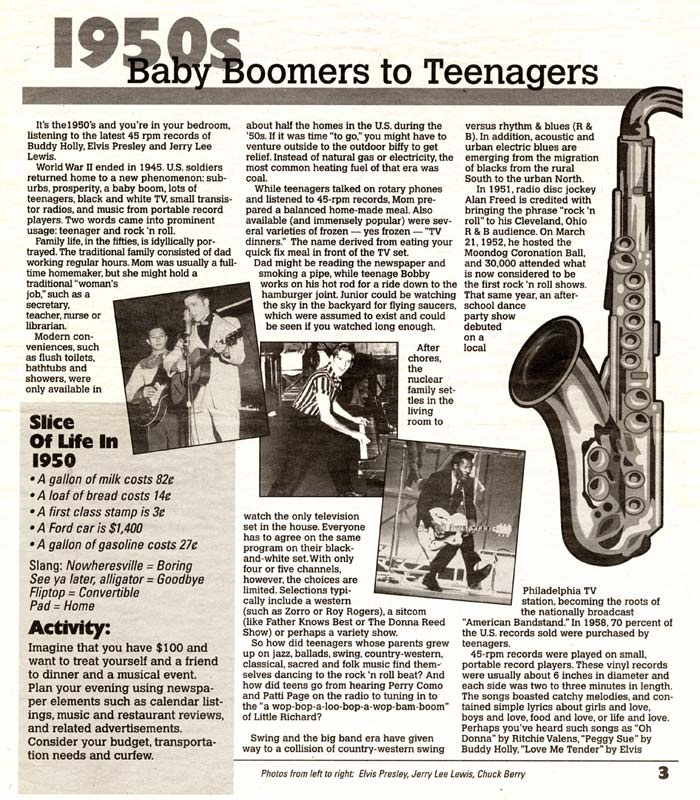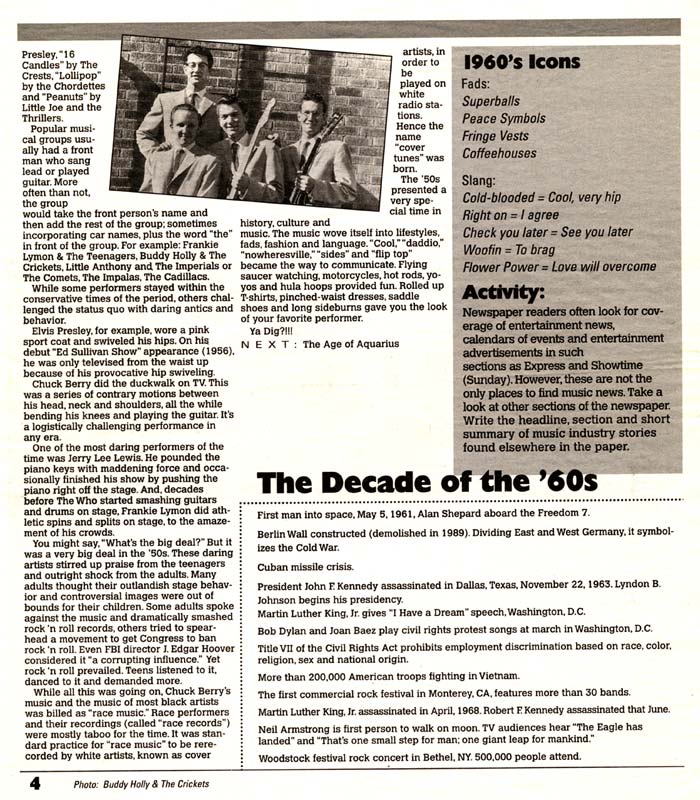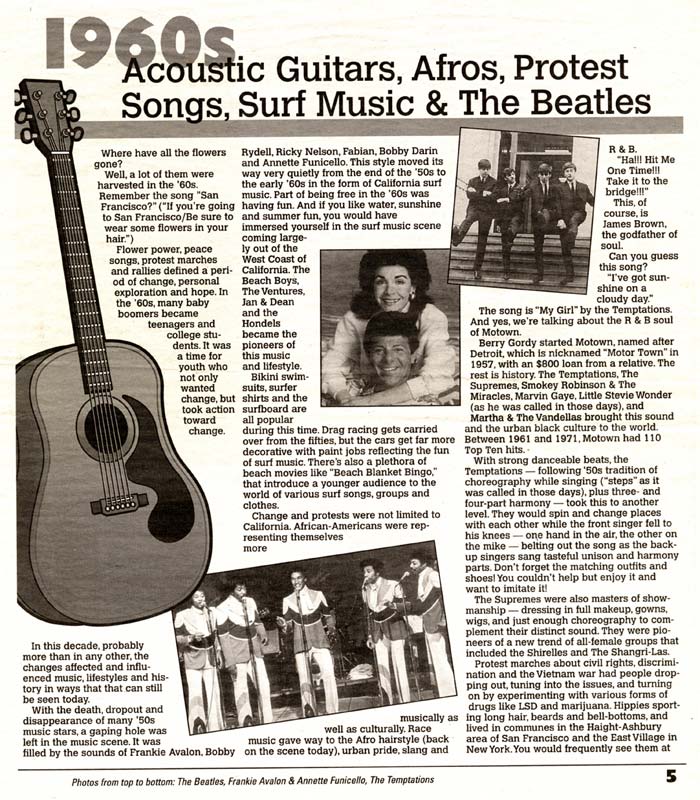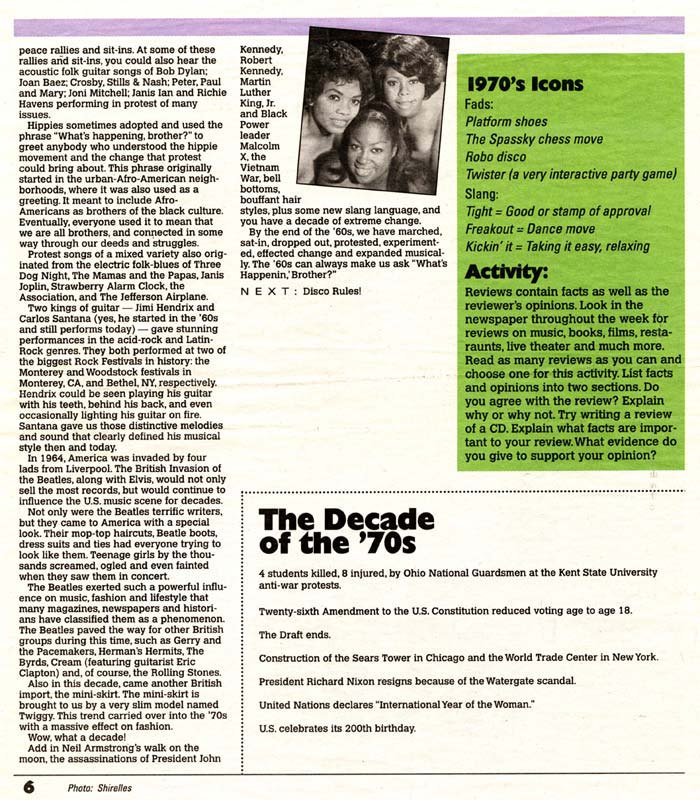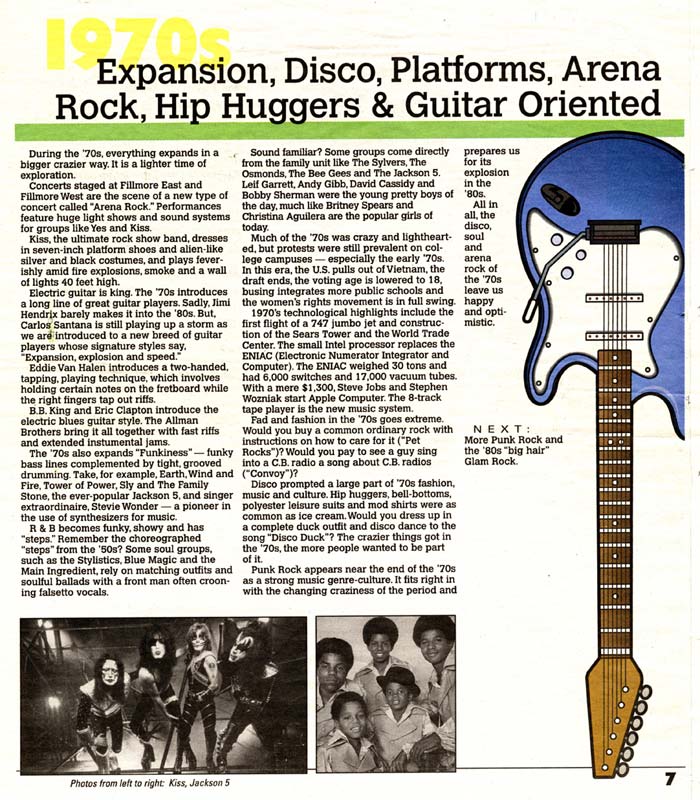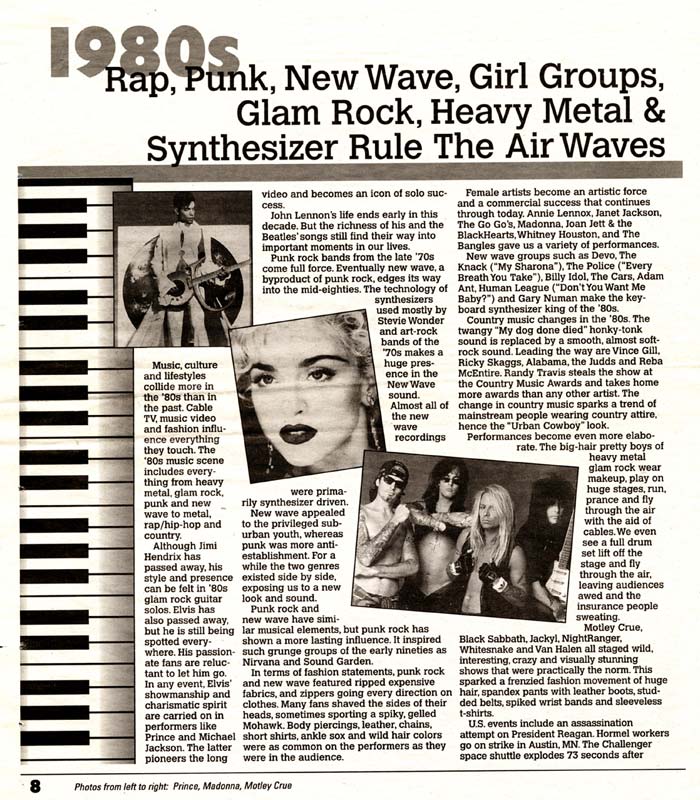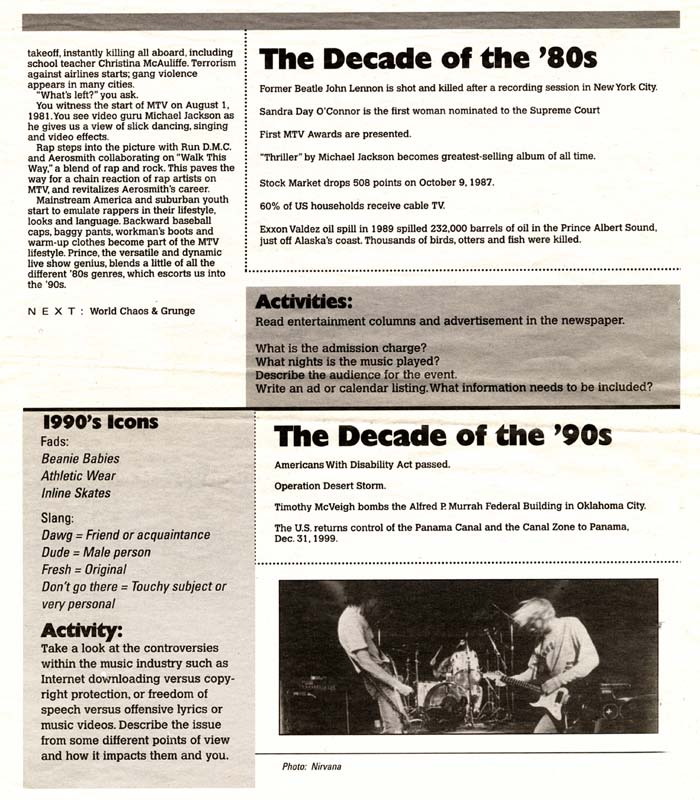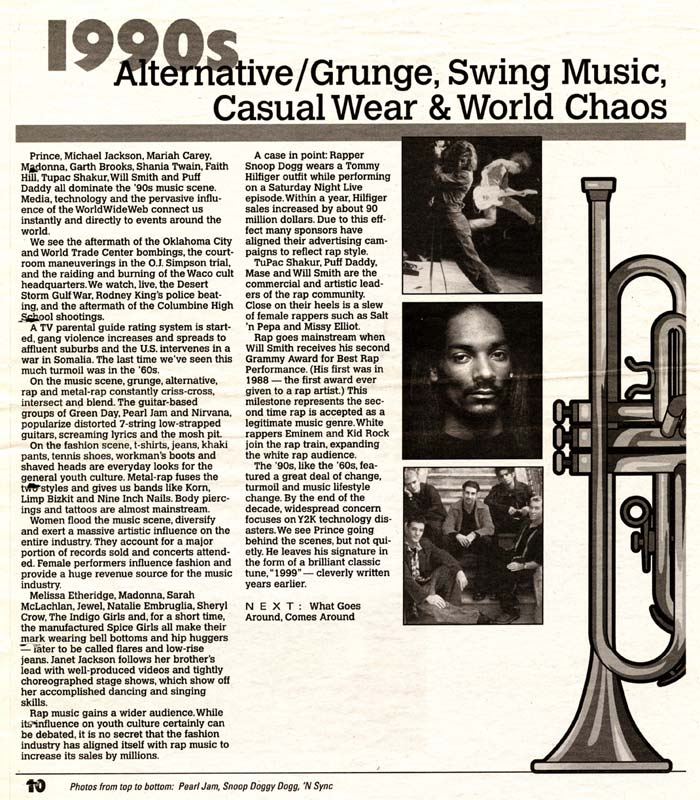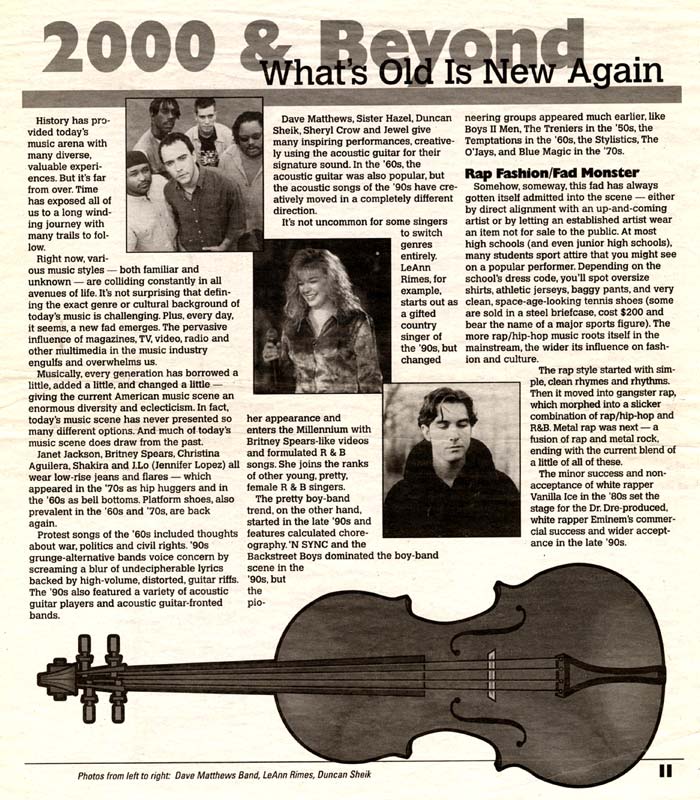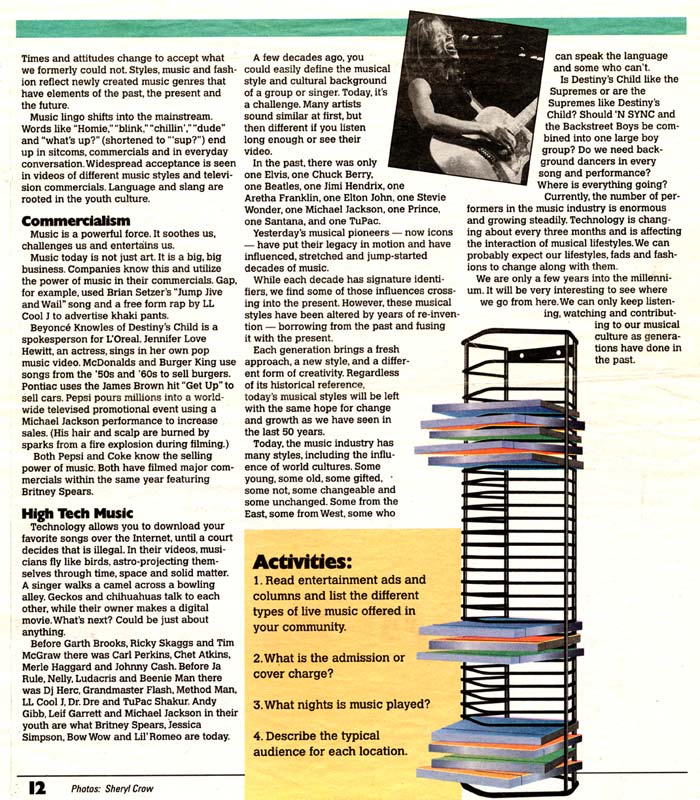50 Years of American Pop Music
It's Trends & Lifestyles
Written by Soli Hughes
Edited by Rob Hubbard
Designed by Molly Ballis
St. Paul Pioneer Press
Welcome
When you think of American pop music what comes to mind?
- Acoustic protest songs, big hair, glam rock and MTV Rap?
- Glitter ball glitz and disco dancing; or the doo-wop twangy guitar and piano-bass boogie woogie of the '50s?
- How about the chunka-chunka pulse of a '90s alternative/grunge band driven by 7-string guitar and high-jumping guitar players?
- Or perhaps the current diverse blend of metal-rap, country blues, R & B/hip-hop, alternative thrash rock or smooth rhythmic Latin sounds? Throw in calculated teen pop and you've got an eclectic millennium mix.
In the past 50 years, American pop music has diversified and reinvented itself time and time again, through changing lifestyles, fashion, social creativity and musical experimentation. Let's take a journey from the beginning. You might be surprised to see what's old is new again-and again and again and again and again.
The Decade of the '50s
Korean War begins; it ends in 1953.
Leo Fender introduces the Broadcaster and Esquire solid body electric guitars, which are used throughout the decade.
The Sci Fi movie "The Day The Earth Stood Still" premieres, prompting even more people to look for UFOs.
In Cleveland, Ohio DJ Alan Freed organized the "Moondog Coronation Ball," considered by many to be the first rock 'n roll show.
Rosa Parks, an African-American woman, refuses to give up her seat on a bus to a white man in Montgomery, Alabama.
McDonalds opens its first restaurant in Des Plaines, Illinois. Hamburgers are 15 cents.
Ford Thunderbird hits the market for just under $3,000. Minimum wage is 75 cents per hour.
Joseph Salk develops the polio vaccine.
Buddy Holly, J.P. Richardson (the "Big Bopper") & Ritchie Valens perform at the Surf Ballroom on Feb. 2 for the Winter Dance Party in Clear Lake, Iowa. They die the following day in a plane crash.
Alaska becomes the 49th state; Hawaii the 50th.
1950s Baby Boomers to Teenagers.
It's the 1950's and you're in your bedroom, listening to the latest 45 rpm records of Buddy Holly, Elvis Presley and Jerry Lee Lewis. World War II ended in 1945. U.S. soldiers returned home to a new phenomenon: suburbs, prosperity, a baby boom, lots of teenagers, black and white TV, small transistor radios, and music from portable record players. Two words came into prominent usage: teenager and rock 'n roll. Family life, in the fifties, is idyllically portrayed. The traditional family consisted of dad working regular hours. Mom was usually a full-time homemaker, but she might hold a traditional "woman's job," such as a secretary, teacher, nurse or librarian.
Modern conveniences, such as flush toilets, bathtubs and showers, were only available in about half the homes in the U.S. during the '50s. If it was time "to go," you might have to venture outside to the outdoor biffy to get relief. Instead of natural gas or electricity, the most common heating fuel of that era was coal. While teenagers talked on rotary phones and listened to 45 rpm records, Mom prepared a balanced home-made meal. Also available (and immensely popular) were several varieties of frozen-yes frozen-"TV dinners." The name derived from eating your quick fix meal in front of the TV set.
Dad might be reading the newspaper and smoking a pipe, while teenage Bobby works on his hot rod for a ride down to the hamburger joint. Junior could be watching the sky in the backyard for flying saucers, which were assumed to exist and could be seen if you watched long enough.
After chores, the nuclear family settles in the living room to watch the only television set in the house. Everyone has to agree on the same program on their black-and-white set. With only four or five channels, however, the choices are limited. Selections typically include a western (such as Zorro or Roy Rogers), a sitcom (like Father Knows Best or The Donna Reed Show) or perhaps a variety show.
So how did teenagers whose parents grew up on jazz, ballads, swing, country-western, classical, sacred and folk music find themselves dancing to the rock 'n roll beat? And how did teens go from hearing Perry Como and Patti Page on the radio to tuning in to the "a wop-bop-a-loo-bop-a-wop-bam-boom" of Little Richard?
Swing and the big band era have given way to a collision of country-western swing versus rhythm & blues (R & B). In addition, acoustic and urban electric blues are emerging from the migration of blacks from the rural South to the urban North.
In 1951, radio disc jockey Alan Freed is credited with bringing the phrase "rock 'n roll" to his Cleveland, Ohio R & B audience. On March 21, 1952, he hosted the Moondog Coronation Ball, and 30,000 attended what is now considered to be the first rock 'n roll shows. That same year, an after-school dance party show debuted on a local Philadelphia TV station, becoming the roots of the nationally broadcast "American Bandstand." In 1958, 70 percent of the U.S. records sold were purchased by teenagers.
45 rpm records were played on small, portable record players. These vinyl records were usually about 6 inches in diameter and each side was two to three minutes in length. The songs boasted catchy melodies, and contained simple lyrics about girls and love, boys and love, food and love, or life and love. Perhaps you've heard such songs as "Oh Donna" by Ritchie Valens, "Peggy Sue" by Buddy Holly, "Love Me Tender" by Elvis Presley, "16 Candles" by The Crests, "Lollipop" by the Chordettes and "Peanuts" by Little Joe and the Thrillers.
Popular musical groups usually had a front man who sang lead or played guitar. More often than not, the group would take the front person's name and then add the rest of the group; sometimes incorporating car names, plus the word "the" in front of the group. For example: Frankie Lymon & The Teenagers, Buddy Holly & The Crickets, Little Anthony and The Imperials or The Comets, The Impalas, The Cadillacs.
While some performers stayed within the conservative times of the period, others challenged the status quo with daring antics and behavior.
Elvis Presley, for example, wore a pink sport coat and swiveled his hips. On his debut "Ed Sullivan Show" appearance (1956) he was only televised from the waist up because of his provocative hip swiveling.
Chuck Berry did the duckwalk on TV. This was a series of contrary motions between his head, neck and shoulders, all the while bending his knees and playing the guitar. It's a logistically challenging performance in any era.
One of the most daring performers of the time was Jerry Lee Lewis. He pounded the piano keys with maddening force and occasionally finished his show by pushing the piano right off the stage. And, decades before The Who started smashing guitars and drums on stage, Frankie Lymon did athletic spins and splits on stage, to the amazement of his crowds.
You might say, "What's the big deal?" But it was a very big deal in the '50s. These daring artists stirred up praise from the teenagers and outright shock from the adults. Many adults thought their outlandish stage behavior and controversial images were out of bounds for their children. Some adults spoke against the music and dramatically smashed rock 'n roll records, others tried to spearhead a movement to get Congress to ban rock 'n roll. Even FBI director J. Edgar Hoover considered it "a corrupting influence." Yet rock 'n roll prevailed. Teens listened to it, danced to it and demanded more.
While all this was going on, Chuck Berry's music and the music of most black artists was billed as "race music." Race performers and their recordings (called "race records") were mostly taboo for the time. It was standard practice for "race music" to be rerecorded by white artists, known as cover artists in order to be played on white radio stations. Hence the name "cover tunes" was born.
The '50s presented a very special time in history, culture and music. The music wove itself into lifestyles, fads, fashion and language. "Cool," "daddio," "nowheresville," "sides" and "flip top" became the way to communicate. Flying saucer watching, motorcycles, hot rods, yo-yos and hula hoops provided fun. Rolled up T-shirts, pinched-waist dresses, saddle shoes and long sideburns gave you the look of your favorite performer.
Ya Dig?!!!
NEXT : The Age of Aquarius
The Decade of the '60s
First man into space, May 5, 1961, Alan Shepard aboard the Freedom 7.
Berlin Wall constructed (demolished in 1989). Dividing East and West Germany, it symbolizes the Cold War.
Cuban missile crisis.
President John F. Kennedy assassinated in Dallas, Texas, November 22, 1963. Lyndon B. Johnson begins his presidency.
Martin Luther King, Jr. gives "I Have a Dream" speech, Washington, D.C.
Bob Dylan and Joan Baez play civil rights protest songs at march in Washington, D.C.
Title VII of the Civil Rights Act prohibits employment discrimination based on race, color, religion, sex and national origin.
More than 200,000 American troops fighting in Vietnam.
The first commercial rock festival in Monterey, CA, features more than 30 bands.
Martin Luther King, Jr. assassinated in April, 1968. Robert F. Kennedy assassinated that June.
Neil Armstrong is first person to walk on moon. TV audiences hear "The Eagle has landed" and "That's one small step for man; one giant leap for mankind."
Woodstock festival rock concert in Bethel, NY. 500,000 people attend.
1960s
Acoustic Guitars, Afros, Protest Songs, Surf Music & The Beatles
Where have all the flowers gone?
Well, a lot of them were harvested in the '60s. Remember the song "San Francisco?" ("If you're going to San Francisco/Be sure to wear some flowers in your hair.")
Flower power, peace songs, protest marches and rallies defined a period of change, personal exploration and hope. In the '60s, many baby boomers became teenagers and college students. It was a time for youth who not only wanted change, but took action toward change.
In this decade, probably more than in any other, the changes affected and influenced music, lifestyles and history in ways that can still be seen today.
With the death, dropout and disappearance of many '50s music stars, a gaping hole was left in the music scene. It was filled by the sounds of Frankie Avalon, Bobby Rydell, Ricky Nelson, Fabian, Bobby Darin and Annette Funicello. This style moved its way very quietly from the end of the '50s to the early '60s in the form of California surf music. Part of being free in the '60s was having fun. And if you like water, sunshine and summer fun, you would have immersed yourself in the surf music scene coming largely out of the West Coast of California. The Beach Boys, The Ventures, Jan & Dean and the Hondels became the pioneers of this music and lifestyle.
Bikini swimsuits, surfer shirts and the surfboard are all popular during this time. Drag racing gets carried over from the fifties, but the cars get far more decorative with paint jobs reflecting the fun of surf music. There's also a plethora of beach movies like "Beach Blanket Bingo," that introduce a younger audience to the world of various surf songs, groups and clothes.
Change and protests were not limited to California. African-Americans were representing themselves more musically as well as culturally. Race music gave way to the Afro hairstyle (back on the scene today), urban pride, slang, and R & B.
"Ha!!! Hit Me One Time!!! Take it to the bridge!!!"
This, of course, is James Brown, the godfather of soul
Can you guess this song?
"I've got sunshine on a cloudy day."
The song is "My Girl" by the Temptations. And yes, we're talking about the R & B soul of Motown.
Berry Gordy started Motown, named after Detroit, which is nicknamed "Motor Town" in 1957, with an $800 loan from a relative. The rest is history. The Temptations, The Supremes, Smokey Robinson & The Miracles, Marvin Gaye, Little Stevie Wonder (as he was called in those days), and Martha & The Vandellas brought this sound and the urban black culture to the world. Between 1961 and 1971, Motown had 110 Top Ten hits.
With strong danceable beats, the Temptations - following '50s tradition of choreography while singing ("steps" as it was called in those days), plus three- and four-part harmony-took this to another level. They would spin and change places with each other while the front singer fell to his knees-one hand in the air, the other on the mike-belting out the song as the back-up singers sang tasteful unison and harmony parts. Don't forget the matching outfits and shoes! You couldn't help but enjoy it and want to imitate it!
The Supremes were also masters of showmanship-dressing in full makeup, gowns, wigs, and just enough choreography to complement their distinct sound. They were pioneers of a new trend of all-female groups that included the Shirelles and The Shangri-Las.
Protest marches about civil rights, discrimination and the Vietnam War had people dropping out, tuning into the issues, and turning on by experimenting with various forms of drugs like LSD and marijuana. Hippies sporting long hair, beards and bell-bottoms, and lived in communes in the Haight-Ashbury area of San Francisco and the East Village in New York. You would frequently see them at peace rallies and sit-ins. At some of these rallies and sit-ins, you could also hear the acoustic folk guitar songs of Bob Dylan; Joan Baez; Crosby, Stills & Nash; Peter, Paul and Mary; Joni Mitchell; Janis Ian and Richie Havens performing in protest of many issues.
Hippies sometimes adopted and used the phrase "What's happening, brother?" to greet anybody who understood the hippie movement and the change that protest could bring about. This phrase originally started in the urban-Afro-American neighborhoods, where it was also used as a greeting. It meant to include Afro-Americans as brothers of the black culture. Eventually, everyone used it to mean that we are all brothers, and connected in some way through our deeds and struggles.
Protest songs of a mixed variety also originated from the electric folk-blues of Three Dog Night, The Mamas and the Papas, Janis Joplin, Strawberry Alarm Clock, the Association, and The Jefferson Airplane.
Two kings of guitar-Jimi Hendrix and Carlos Santana (yes, he started in the '60s and still performs today)-gave stunning performances in the acid-rock and Latin-Rock genres. They both performed at two of the biggest Rock Festivals in history: the Monterey and Woodstock festivals in Monterey, CA and Bethel, NY, respectively. Hendrix could be seen playing his guitar with his teeth, behind his back, and even occasionally lighting his guitar on fire. Santana gave us those distinctive melodies and sound that clearly defined his musical style then and today.
In 1964, America was invaded by four lads from Liverpool. The British Invasion of the Beatles, along with Elvis, would not only sell the most records, but would continue to influence the U.S. music scene for decades.
Not only were the Beatles terrific writers, but they came to America with a special look. Their mop-top haircuts, Beatle boots, dress suits and ties had everyone trying to look like them. Teenage girls by the thousands screamed, ogled and even fainted when they saw them in concert.
The Beatles exerted such a powerful influence on music, fashion and lifestyle that many magazines, newspapers and historians have classified them as a phenomenon. The Beatles paved the way for other British groups during this time, such as Gerry and the Pacemakers, Herman's Hermits, The Byrds, Cream (featuring guitarist Eric Clapton) and, of course, The Rolling Stones.
Also in this decade, came another British import, the mini-skirt. The mini-skirt is brought to us by a very slim model named Twiggy. This trend carried over into the '70s with a massive effect on fashion.
Wow, what a decade!
Add in Neil Armstrong's walk on the moon, the assassinations of President John Kennedy, Robert Kennedy, Martin Luther King, Jr. and Black Power leader Malcolm X, the Vietnam War, bell bottoms, bouffant hair styles, plus some new slang language and you have a decade of extreme change.
By the end of the '60s, we have marched, sat-in, dropped out, protested, experimented, effected change and expanded musicality. The '60s can always make us ask "What's Happenin', Brother?"
NEXT : Disco Rules!
The Decade of the '70s
4 students killed, 8 injured, by Ohio National Guardsmen at the Kent State University anti-war protests.
Twenty-sixth Amendment to the U.S. Constitution reduced voting age to age 18.
The Draft ends.
Construction of the Sears Tower in Chicago and the World Trade Center in New York.
President Richard Nixon resigns because of the Watergate scandal.
United Nations declares "International Year of the Woman."
U.S. celebrates its 200th birthday.
1970s
Expansion, Disco, Platforms, Arena Rock, Hip Huggers & Guitar Oriented
During the '70s, everything expands in a bigger crazier way. It is a lighter time of exploration.
Concerts staged at Fillmore East and Fillmore West are the scene of a new type of concert called "Arena Rock." Performances feature huge light shows and sound systems for groups like Yes and Kiss.
Kiss, the ultimate rock show band, dresses in seven-inch platform shoes and alien-like silver and black costumes, and plays feverishly amid fire explosions, smoke and a wall of lights 40 feet high.
Electric guitar is king. The '70s introduces a long line of great guitar players. Sadly, Jimi Hendrix barely makes it into the '70s. But Carlos Santana is still playing up a storm as we are introduced to a new breed of guitar players whose signature styles say, "Expansion, explosion and speed."
Eddie Van Halen introduces a two-handed, tapping, playing technique, which involves holding certain notes on the fretboard while the right fingers tap out riffs.
B.B. King and Eric Clapton introduce the electric blues guitar style. The Allman Brothers bring it all together with fast riffs and extended instrumental jams.
The '70s also expands "Funkiness"- funky bass lines complemented by tight, grooved drumming. Take, for example, Earth, Wind, and Fire, Tower of Power, Sly and The Family Stone, the ever-popular Jackson 5, and singer extraordinaire, Stevie Wonder - a pioneer in the use of synthesizers for music.
R & B becomes funky, showy and has "steps." Remember the choreographed "steps" from the '50s? Some soul groups, such as the Stylistics, Blue Magic and the Main Ingredient, rely on matching outfits and soulful ballads with a front man often crooning falsetto vocals.
Sound familiar? Some groups come directly from the family unit like The Sylvers, The Osmonds, The Bee Gees and The Jackson 5. Leif Garret, Andy Gibb, David Cassidy and Bobby Sherman were the young pretty boys of the day, much like Britney Spears and Christina Aguilera are the popular girls of today.
Much of the '70s was crazy and lighthearted, but protests were still prevalent on college campuses -especially the early '70s. In this era, the U.S. pulls out of Vietnam, the draft ends, the voting age is lowered to 18, busing integrates more public schools and the women's rights movement is in full swing.
1970's technological highlights include the first flight of a 747 jumbo jet and construction of the Sears Tower and the World Trade Center. The small Intel Processor replaces the ENIAC (Electronic Numerator Integrator and Computer). The ENIAC weighted 30 tons and had 6,000 switches and 17,000 vacuum tubes. With a mere $1,300, Steve Jobs and Stephen Wozniak start Apple Computer. The 8-track tape player is the new music system.
Fad and fashion in the '70s goes extreme. Would you buy a common ordinary rock with instructions on how to care for it ("Pet Rocks")? Would you pay to see a guy sing into a C.B. radio a song about C.B. radios ("Convoy")?
Disco prompted a large part of the '70s fashion, music and culture. Hip huggers, bell-bottoms, polyester leisure suits and mod shirts were as common as ice cream. Would you dress up in a complete duck outfit and disco dance to the song "Disco Duck"? The crazier things got in the '70s, the more people wanted to be part of it.
Punk Rock appears near the end of the '70s as a strong music genre-culture. It fits right in with the changing craziness of the period and prepares us for its explosion in the '80s.
All in all, the disco, soul and arena rock of the '70s leave us happy and optimistic.
NEXT: More Punk Rock and the '80s "big hair" Glam Rock.
The Decade of the '80s
Former Beatle John Lennon is shot and killed after a recording session in New York City.
Sandra Day O'Connor is the first woman nominated to the Supreme Court.
First MTV Awards are presented.
"Thriller" by Michael Jackson becomes greatest-selling album of all time.
Stock Market drops 508 points on October 8, 1987.
60% of U.S. households receive cable TV.
Exxon Valdez oil spill in 1989 spilled 232,000 barrels of oil in the Prince Albert Sound, just off Alaska's coast. Thousands of birds, otters and fish were killed.
1980s
Rap, Punk, New Wave, Girl Groups, Glam Rock, Heavy Metal & Synthesizer Rule The Air Waves
Music, culture and lifestyles collide more in the '80s than in the past. Cable TV, music video and fashion influence everything they touch. The '80s music scene includes everything from heavy metal, glam rock, punk and a new wave to metal, rap/hip-hop and country.
Although Jimi Hendrix has passed away, his style and presence can be felt in '80s glam rock guitar solos. Elvis has also passed away, but he is still being spotted everywhere. His passionate fans are reluctant to let him go. In any event, Elvis' showmanship and charismatic spirit are carried on in performers like Prince and Michael Jackson. The latter pioneers the long video and becomes an icon of solo success.
John Lennon's life ends early in this decade. But the richness of his and the Beatles' songs still find their way into important moments in our lives.
Punk rock bands from the late '70s come full force. Eventually new wave, a byproduct of punk rock, edges its way into the mid-eighties. The technology of synthesizers used mostly by Stevie Wonder and art-rock bands of the '70s makes a huge presence in the new wave sound. Almost all of the new wave recordings were primarily synthesizer driven.
New wave appealed to the privileged suburban youth, whereas punk was more anti-establishment. For a while the two genres existed side by side, exposing us to a new look and sound.
Punk rock and new wave have similar musical elements, but punk rock has shown a more lasting influence. It inspired such grunge groups of the early nineties as Nirvana and Sound Garden.
In terms of fashion statements, punk rock and new wave featured ripped expensive fabrics, and zippers going every direction on clothes. Many fans shaved the sides of their heads, sometimes sporting a spiky, gelled Mohawk. Body piercings, leather, chains, short shirts, ankle sox and wild hair colors were as common on the performers as they were in the audience.
Female artists become an artistic force and a commercial success that continues through today. Annie Lennox, Janet Jackson, The Go Go's, Madonna, Joan Jett & The BlackHearts, Whitney Houston, and The Bangles gave us a variety of performances.
New wave groups such as Devo, The Knack ("My Sharona"), The Police ("Every Breath You Take"), Billy Idol, The Cars, Adam Ant, Human League ("Don't You Want Me Baby?") and Gary Numan make the keyboard synthesizer king of the '80s.
Country music changes in the '80s. The twangy "My dog done died" honky-tonk sound is replaced by a smooth, almost soft-rock sound. Leading the way are Vince Gill, Ricky Skaggs, Alabama, the Judds and Reba McEntire. Randy Travis steals the show at the Country Music Awards and takes home more awards than any other artist. The change in country music sparks a trend of mainstream people wearing country attire, hence the "Urban Cowboy" look.
Performances become even more elaborate. The big-hair pretty boys of heavy metal glam rock wear makeup, play on huge stages, run, prance and fly through the air with the aid of cables. We even see a full drum set lift off the stage and fly through the air, leaving audiences awed and the insurance people sweating.
Motley Crue, Black Sabbath, Jackyl, NightRanger, Whitesnake and Van Halen all staged wild, interesting, crazy and visually stunning shows that were practically the norm. This sparked a frenzied fashion movement of huge hair, spandex pants with leather boots, studded belts, spiked wrist bands and sleeveless t-shirts.
U.S. events include an assassination attempt on President Reagan. Hormel workers go on strike in Austin, MN. The Challenger space shuttle explodes 73 seconds after takeoff, instantly killing all aboard, including school teacher Christina McAuliffe. Terrorism against airlines starts; gang violence appears in many cities.
"What's left?" you ask.
You witness the start of MTV on August 1, 1981. You see video guru Michael Jackson as he gives us a view of slick dancing, singing and video effects.
Rap steps into the picture with Run D.M.C. and Aerosmith collaborating on "Walk This Way," a blend of rap and rock. This paves the way for a chain reaction of rap artists on MTV, and revitalizes Aerosmith's career.
Mainstream America and suburban youth start to emulate rappers in their lifestyle, looks and language. Backward baseball caps, baggy pants, workman's boots and warm-up clothes become part of the MTV lifestyle. Prince, the versatile and dynamic live show genius, blends a little of all the different '80s genres, which escorts us into the '90s.
The Decade of the '90s
Americans with Disability Act passed.
Operation Desert Storm.
Timothy McVeigh bombs the Alfred P. Murrah Federal Building in Oklahoma City.
The U.S. returns control of the Panama Canal and the Canal Zone to Panama, Dec. 31, 1999.
1990s
Althernative/Grunge, Swing Music, Casual Wear & World Chaos
Prince, Michael Jackson, Mariah Carey, Madonna, Garth Brooks, Shania Twain, Faith Hill, Tupac Shakur, Will Smith and Puff Daddy all dominate the '90s music scene. Media technology and the pervasive influence of the WoldWideWeb connect us instantly and directly to events around the world.
We see the aftermath of the Oklahoma City and World Trade Center bombings, the courtroom maneuverings in the O.J. Simpson trial, and the raiding and burning of the Waco cult headquarters. We watch, live, the Desert Storm Gulf War, Rodney King's police beating, and the aftermath of the Columbine High School shootings.
A TV parental guide rating system is started, gang violence increases and spreads to affluent suburbs and the U.S. intervenes in a war in Somalia. The last time we've seen this much turmoil was in the '60s.
On the music scene, grunge, alternative, rap and metal-rap constantly criss-cross, intersect and blend. The guitar-based groups of Green Day, Pearl Jam and Nirvana popularize distorted 7-string low-strapped guitars, screaming lyrics and the mosh pit.
On the fashion scene, t-shirts, jeans, khaki pants, tennis shoes, workman's boots and shaved heads are everyday looks for the general youth culture. Metal-rap fuses the two styles and gives us bands like Korn, Limp Bizkit and Nine Inch Nails. Body piercings and tattoos are almost mainstream.
Women flood the music scene, diversify and exert a massive artistic influence on the entire industry. They account for a major portion of records sold and concerts attended. Female performers influence fashion and provide a huge revenue source for the music industry.
Melissa Etheridge, Madonna, Sarah McLachlan, Jewel, Natalie Embruglia, Sheryl Crow, The Indigo Girls and, for a short time, the manufactured Spice Girls all make their mark wearing bell bottoms and hip huggers-later to be called flares and low-rise jeans. Janet Jackson follows her brother's lead with well-produced videos and tightly choreographed stage shows, which show off her accomplished dancing and singing skills.
Rap music gains a wider audience. While its influence on youth culture certainly can be debated, it is no secret that the fashion industry has aligned itself with rap music to increase its sales by millions. A case in point: Rapper Snoop Dogg wears a Tommy Hilfiger outfit while performing on a Saturday Night Live episode. Within a year, Hilfiger sales increased by about 90 million dollars. Due to this effect many sponsors have aligned their advertising campaigns to reflect rap style.
TuPac Shakur, Puff Daddy, Mase and Will Smith are the commercial and artistic leaders of the rap community. Close on their heels is a slew of female rappers such as Salt 'n Pepa and Missy Elliot.
Rap goes mainstream when Will Smith receives his second Grammy Award for Best Rap Performance. (His first was in 1988-the first award ever given to a rap artist.) This milestone represents the second time rap is accepted as a legitimate music genre. White rappers Eminem and Kid Rock join the rap train, expanding the white rap audience.
The '90s, like the '60s, featured a great deal of change, turmoil and music lifestyle change. By the end of the decade, widespread concern focuses on Y2K technology disasters. We see Prince going behind the scenes, but not quietly. He leaves his signature in the form of a brilliant classic tune, "1999" -cleverly written years earlier.
NEXT : What Goes Around, Comes Around
2000 & Beyond
What's Old Is New Again
History has provided today's music arena with many diverse, valuable experiences. But it's far from over. Time has exposed all of us to a long winding journey with many trails to follow.
Right now, various music styles-both familiar and unknown-are colliding constantly in all avenues of life. It's not surprising that defining the exact genre or cultural background of today's music is challenging. Plus, every day, it seems, a new fad emerges. The pervasive influence of magazines, TV, video, radio and other multimedia in the music industry engulfs and overwhelms us.
Musically, every generation has borrowed a little, added a little, and changed a little-giving the current American music scene an enormous diversity and eclecticism. In fact, today's music scene has never presented so many different options. And much of today's music scene does draw from the past.
Janet Jackson, Britney Spears, Christian Aguilera, Shakira and J.Lo (Jennifer Lopez) all wear low-rise jeans and flares-which appeared in the '70s as hip huggers and in the '60s as bell bottoms. Platform shoes, also prevalent in the '60s and '70s, are back again.
Protest songs of the '60s included thoughts about war, politics and civil rights. '90s grunge-alternative bands voice concern by screaming a blur of undecipherable lyrics backed by high-volume, distorted, guitar riffs. The '90s also featured a variety of acoustic guitar players and acoustic guitar-fronted bands.
Dave Matthews, Sister Hazel, Duncan Sheik, Sheryl Crow and Jewel give many inspiring performances, creatively using the acoustic guitar for their signature sound. In the '60s, the acoustic guitar was also popular, but the acoustic songs of the '90s have creatively moved in a completely different direction.
It's not uncommon for some singers to switch genres entirely. LeAnn Rimes, for example, starts out as a gifted country singer of the '90s but changed her appearance and enters the Millennium with Britney Spears-like videos and formulated R & B songs. She joins the ranks of other young, pretty, female R & B singers.
The pretty boy-band trend, on the other hand, started in the late '90s and features calculated choreography. 'N Sync and the Backstreet Boys dominated the boy-band scene in the '90s, but the pioneering groups appeared much earlier, like Boys II Men, The Treniers in the '50s the Temptations in the '60s, the Stylistics, The O'Jays, and Blue Magic in the '70s.
Rap Fashion/Fad Monster
Somehow, someway, this fad has always gotten itself admitted into the scene-either by direct alignment with an up-and-coming artist or by letting an established artist wear an item not for sale to the public. At most high schools (and even junior high schools), many students sport attire that you might see on a popular performer. Depending on the school's dress code, you'll spot oversize shirts, athletic jerseys, baggy pants, and very clean, space-age-looking tennis shoes (some are sold in a steel briefcase, cost $200 and bear the name of a major sports figure). The more rap/hip-hop music roots itself in the mainstream, the wider its influence on fashion and culture.
The rap style started with simple, clean rhymes and rhythms. Then it moved into gangster rap, which morphed into a slicker combination of rap/hip-hop and R&B. Metal rap was next-a fusion of rap and metal rock, ending with the current blend of a little of all of these.
The minor success and nonacceptance of white rapper Vanilla Ice in the '80s set the stage for the Dr. Dre-produced, white rapper Eminem's commercial success and wider acceptance in the late '90s.
Times and attitudes change to accept what we formerly could not. Styles, music and fashion reflect newly created music genres that have elements of the past, the present and the future.
Music lingo shifts into the mainstream. Words like "Homie," "blink," "chillin'," "dude" and "what's up?" (shortened to "'sup?") end up in sitcoms, commercials and in everyday conversation. Widespread acceptance is seen in videos of different music styles and television commercials. Language and slang are rooted in the youth culture.
Commercialism
Music is a powerful force. It soothes us, challenges us and entertains us.
Music today is not just art. It is a big, big business. Companies know this and utilize the power of music in their commercials. Gap, for example, used Brian Setzer's "Jump Jive and Wail" song and a free form rap by LL Cool J to advertise khaki pants.
Beyoncé Knowles of Destiny's Child is a spokesperson for L'Oreal. Jennifer Love Hewitt, an actress, sings in her own pop music video. McDonalds and Burger King use songs from the '50s and '60s to sell burgers. Pontiac uses the James Brown hit "Get Up" to sell cars. Pepsi pours millions into a world-wide televised promotional event using a Michael Jackson performance to increase sales. (His hair and scalp are burned by sparks from a fire explosion during filming.)
Both Pepsi and Coke know the selling power of music. Both have filmed major commercials within the same year featuring Britney Spears.
High Tech Music
Technology allows you to download your favorite songs over the Internet, until a court decides that it's illegal. In their videos, musicians fly like birds, astro-projecting themselves through time, space and solid matter. A singer walks a camel across a bowling alley. Geckos and Chihuahuas talk to each other, while their owner makes a digital movie. What's next? Could be just about anything.
Before Garth Brooks, Ricky Skaggs and Tim McGraw there was Carl Perkins, Chet Atkins, Merle Haggard and Johnny Cash. Before Ja Rule, Nelly, Ludacris and Beenie Man there was Dj Herc, Grandmaster Flash, Method Man, LL Cool J, Dr. Dre and TuPac Shakur. Andy Gibb, Leif Garret and Michael Jackson in their youth are what Britney Spears, Jessica Simpson, Bow Wow and Lil' Romeo are today.
A few decades ago, you could easily define the musical style and cultural background of a group or singer. Today, it's a challenge. Many artists sound similar at first, but then different if you listen long enough or see their video.
In the past, there was only one Elvis, one Chuck Berry, one Beatles, one Jimi Hendrix, one Aretha Franklin, one Elton John, one Stevie Wonder, one Michael Jackson, one Prince, one Santana, and one TuPac.
Yesterday's musical pioneers-now icons-have put their legacy in motion and have influenced, stretched and jump-started decades of music.
While each decade has signature identifiers, we find some of those influences crossing into the present. However, these musical styles have been altered by years of re-invention-borrowing from the past and fusing it with the present.
Each generation brings a fresh approach, a new style, and a different form of creativity. Regardless of its historical reference, today's musical styles will be left with the same hope for change and growth as we have seen in the last 50 years.
Today, the music industry has many styles, including the influence of world cultures. Some young, some old, some gifted, some not, some changeable and some unchanged. Some from the East, some from the West, some who can speak the language and some who can't.
Is Destiny's Child like the Supremes or are the Supremes like Destiny's Child? Should'N SYNC and the Backstreet Boys be combined into one large boy group? Do we need background dancers in every song and performance?
Currently, the number of performers in the music industry is enormous and growing steadily. Technology is changing about every three months and is affecting the interaction of musical lifestyles. We can probably expect our lifestyles, fads and fashions to change along with them.
We are only a few years into the millennium. It will be very interesting to see where we go from here. We can only keep listening, watching and contributing to our musical culture as generations have done in the past.
